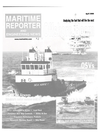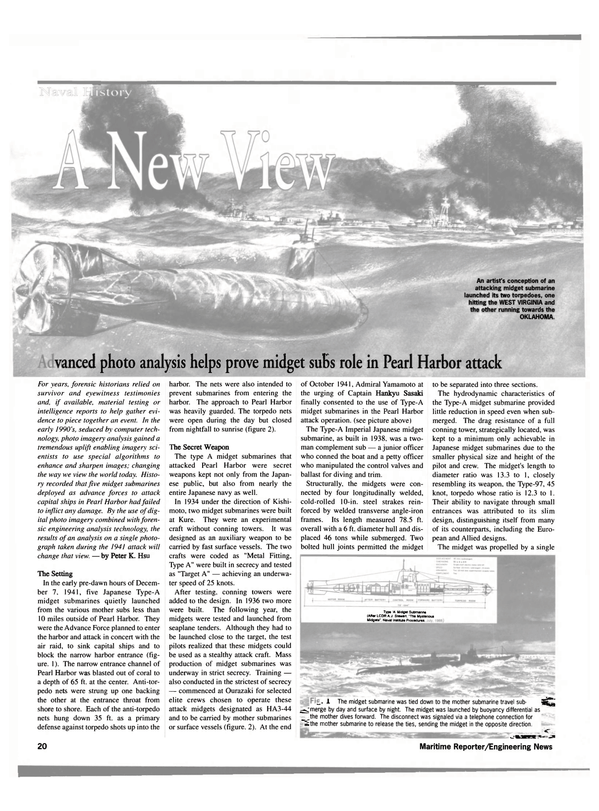
A New View
Advanced photo analysis helps prove midget subs role in Pearl Harbor attack For years, forensic historians relied on survivor and eyewitness testimonies and, if available, material testing or intelligence reports to help gather evidence to piece together an event. In the early 1990's, seduced by computer technology, photo imagery analysis gained a tremendous uplift enabling imagery scientists to use special algorithms to enhance and sharpen images; changing the way we view the world today. History recorded that five midget submarines deployed as advance forces to attack capital ships in Pearl Harbor had failed to inflict any damage. By the use of digital photo imagery combined with forensic engineering analysis technology, the results of an analysis on a single photograph taken during the 1941 attack will change that view. — by Peter K. Hsu The Setting In the early pre-dawn hours of December 7, 1941, five Japanese Type-A midget submarines quietly launched from the various mother subs less than 10 miles outside of Pearl Harbor. They were the Advance Force planned to enter the harbor and attack in concert with the air raid, to sink capital ships and to block the narrow harbor entrance (figure.
1). The narrow entrance channel of Pearl Harbor was blasted out of coral to a depth of 65 ft. at the center. Anti-torpedo nets were strung up one backing the other at the entrance throat from shore to shore. Each of the anti-torpedo nets hung down 35 ft. as a primary defense against torpedo shots up into the harbor. The nets were also intended to prevent submarines from entering the harbor. The approach to Pearl Harbor was heavily guarded. The torpedo nets were open during the day but closed from nightfall to sunrise (figure 2).
The Secret Weapon The type A midget submarines that attacked Pearl Harbor were secret weapons kept not only from the Japanese public, but also from nearly the entire Japanese navy as well.
In 1934 under the direction of Kishimoto, two midget submarines were built at Kure. They were an experimental craft without conning towers. It was designed as an auxiliary weapon to be carried by fast surface vessels. The two crafts were coded as "Metal Fitting, Type A" were built in secrecy and tested as "Target A" — achieving an underwater speed of 25 knots.
After testing, conning towers were added to the design. In 1936 two more were built. The following year, the midgets were tested and launched from seaplane tenders. Although they had to be launched close to the target, the test pilots realized that these midgets could be used as a stealthy attack craft. Mass production of midget submarines was underway in strict secrecy. Training — also conducted in the strictest of secrecy — commenced at Ourazaki for selected elite crews chosen to operate these attack midgets designated as HA3-44 and to be carried by mother submarines or surface vessels (figure. 2). At the end of October 1941, Admiral Yamamoto at the urging of Captain Hankyu Sasaki finally consented to the use of Type-A midget submarines in the Pearl Harbor attack operation, (see picture above) The Type-A Imperial Japanese midget submarine, as built in 1938, was a twoman complement sub — a junior officer who conned the boat and a petty officer who manipulated the control valves and ballast for diving and trim.
Structurally, the midgets were connected by four longitudinally welded, cold-rolled 10-in. steel strakes reinforced by welded transverse angle-iron frames. Its length measured 78.5 ft.
overall with a 6 ft. diameter hull and displaced 46 tons while submerged. Two bolted hull joints permitted the midget to be separated into three sections.
The hydrodynamic characteristics of the Type-A midget submarine provided little reduction in speed even when submerged.
The drag resistance of a full conning tower, strategically located, was kept to a minimum only achievable in Japanese midget submarines due to the smaller physical size and height of the pilot and crew. The midget's length to diameter ratio was 13.3 to 1, closely resembling its weapon, the Type-97, 45 knot, torpedo whose ratio is 12.3 to 1.
Their ability to navigate through small entrances was attributed to its slim design, distinguishing itself from many of its counterparts, including the European and Allied designs.
The midget was propelled by a single 600-hp electric motor via single geared shaft with contra-rotating propellers.
Power was supplied from acid-cell batteries but without on-board recharging generators. Re-charging could only be accomplished by a mother sub or by a tender. She had a top speed of 23 knots surfaced and 19 knots submerged for 55 minutes of battery power. However, at a submerged speed of 2 knots, the midget had an effective range of 100 miles.
The midget submarine carried two 18- in. torpedo tubes mounted one over another. For the Pearl Harbor attack operation, it was armed with two Type- 97 torpedoes, each with an approximately 800-lb. explosive warhead, twice the amount in the Type-91 aerial torpedo.
The Japanese torpedoes fueled by oxygen, leaving hardly any wake, are capable of hitting targets faster from longer range. They were considered more advanced than the allied forces.
The Attack At 0755 the first wave of the Japanese carrier planes commenced their attack at their targets. The first wave of torpedo bombers "Kate" B2N5 attacked in groups, flying in an opposite direction attack pattern. The light cruiser USS HELENA was torpedoed while the other group attacked Battleship row. The USS Helena was hit at 0758, recorded in her ship's log. This time was a critical datum for establishing a torpedo attack timeline in the forensic analysis. The rear gunner of a "Kate" took a series of photographs as she flew over the target.
One of which was released and shown to the world as propaganda by Japan. This perhaps was one of the most important combat photos of its time.
Presence of a Submarine In 1994, Historian and National Park service of the USS Arizona (BB38) memorial, Daniel Martinez and noted historian and journalist, Burl Burlingham, suggested that the combat photos contained an image of a Japanese midget submarine near Battleship row.
An Arlington photo-imagery company digitized the photo and by use of computer algorithm technology, enhanced and sharpened the image of the suspected submarine. Measurements of the submarine were obtained for comparison by triangulation and special imagery techniques employed. Measurements were computed by referencing a scaled stereo imagery of the harbor taken by the Army Air Corp at the end of November.
A detailed version of the photogrammetry analysis was published by The U.S. Naval Institute in the December 1999 issue of Naval History magazine.
Image Source and Identification The combat photograph, figure 4, for the forensic analysis was provided by the Naval Historical Center. It was taken during the first wave of the attack by the Japanese Navy carrier based Nakajima B5N2 "Kate" torpedo bomber.
This aerial photograph was published in the Japanese press shortly after the Pearl Harbor attack. This photographic image is considered one of the most dramatic combat photographs taken during the 20th Century. Shortly after the attack on Pearl Harbor, an American citizen living in Spain obtained the original positive photo print. It was reported that he received the photograph from the Japanese Embassy in Madrid. Since the original negative has never been found, all subsequent reproductions have come from the lone photograph kept at the Navy Historical Center in the Navy Yard. Imperial Japanese naval history recorded that five Type-A class midget submarines were planned in concert with the main force to attack Pearl Harbor.
An anomaly was captured on the surface in the photograph taken by an Imperial Japanese Navy flight crew.
With this premise it formed the basis for the photo imagery analysis.
Read A New View in Pdf, Flash or Html5 edition of April 2000 Maritime Reporter
Other stories from April 2000 issue
Content
- Corsaire 13000 Embodies Integrated, Advanced Propulsion System page: 48D
- Jotun: Greening the trade in crude page: 8
- Financing Sources for U.S. Government Programs page: 14
- Deltamarin And Almaco Join Together page: 18
- ASRY Reports Prosperous 1999 page: 18
- A New View page: 20
- The Smokeless Solution Is Coming Over The Horizon page: 22
- Strategic Value Adding Purchasing page: 28
- DCR Optimistic About Future Of Offshore Drilling Sector page: 34
- Offshore Industry Leaders Invest Heavily In Safety Programs page: 36
- Electronic Engines Power New OSV Breed page: 40
- Angola And Canada Provide Projects For Smit Pioneer page: 40
- Rig Repowered At Houston Ship Repair page: 41
- Charting The World Electronically page: 44
- Reality Checked page: 45
- NoFire Technologies Helps Ships Meet SOLAS page: 48
- Is Diesel-Electric Propulsion the System for You? page: 50
- Drew Marine, MAN B&W Launch Redesigned Fuel Mill page: 52
- Austal Breaks 24-Hour Record page: 53
- PropExpert V. 4.2 Released page: 53
- GE To Supply Gas Turbines For IHI page: 54
- Jabsco Offers Oil Change Kit page: 54
- Calling All Mariners page: 56
- MTN, BT Hook-Up Cruise Ships To Cell Phone Network page: 59
- Norwegian Manufacturers Maintain Edge page: 60
- Leica Extends Its Influence In DGPS Arena page: 69
- ViaSat Ups Phase Two page: 69
- Encouraging best practice onboard using video and interactive media page: 73
- Blount Completes Dinner Vessel page: 74
- ACCL Offers New Chicago-Based Cruises page: 78
- Boatracs To Exclusively Distribute MarStar page: 78
- DNV Cleans Up With Celebrity's Millennium page: 79
- Transas Unveils GMDSS Simulator page: 85


